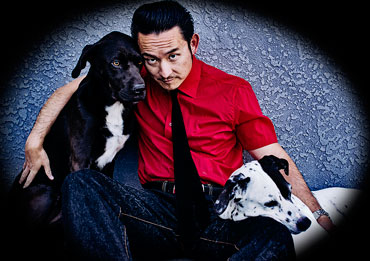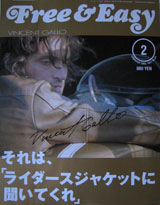MANIOS DIGITAL & FILM INTERVIEW (2015)
Documentarian: Hikari Takano
Hikari Takano was born in Tokyo, Japan, in 1964. After attending boarding schools in England, he enrolled at the University of Redlands in California. Takano, 4 a year varsity player and NCAA Division III National Champion in Tennis, graduated with in 1987 with a B.A. in History.
In 1988, Hikari moved to N.Y. to study acting with the legendary Sanford Meisner at the Neighborhood Playhouse.
In 1991, Hikari made his feature film debut in Fred Schepisi’s “Mr. Baseball”, starring Tom Selleck. He also served as Mr. Selleck’s bilingual assistant for the four month shoot in Japan.
In 1992, Hikari was cast as Leon in Barry Sonnenfeld’s “For Love or Money”, starring Michael J. Fox.
In 1993, Hikari appeared on Benetton’s billboard campaign in Times Square, New York City, for 20 months (photo). Olivieri Toscani photographed the controversial semi-nude billboard.
Hikari appeared in numerous TV commercials (Peugeot commercial), Off-Broadway, and Regional Theatre productions in his 11 years in New York City.
In 1999, Hikari moved back to Los Angeles, California, and began working as an interviewer for magazines like The Book LA, Perfect 10, Penthouse, Free & Easy, Cigar, and numerous Japanese movie magazines.
www.HikariTakano.com was officially launched on September, 2009.
Hikari has had the opportunity to interview hundreds of celebrities, such as: Dennis Hopper, Sydney Pollack, Harvey Keitel, Mickey Rourke, David Carradine, Sugar Ray Leonard, David Lynch, Milos Forman, Norman Jewison, David O. Russell, Joel Schumacher, Mike Figgis, Spike Jonze, Kevin Costner, and Billy Bob Thornton.
INSIDE Hikari Takano Interviews with Hikari Takano
Can you please provide a short background history on your career?
I studied acting in New York with the great Sanford Meisner when he was still alive. I was mostly an actor in New York in the 90’s. I also taught tennis and did some bilingual producing on Japanese TV shows and commercials that came to New York.
When I moved to Los Angeles in 1999 my brother, also an actor, was working as a trainer to the then undefeated boxing champ Oscar De La Hoya. When a very famous Japanese magazine came to interview my brother while he was training Oscar up in Big Bear, California, they asked him if he knew anyone that could help set up future U.S. projects for them. After producing a couple of fashion projects for the magazine I felt like I could do more so I suggested the idea of my doing celebrity interviews. Their reaction was, “Stars! Well, if you can get them then absolutely.” I had no experience booking or interviewing movie stars, directors, or athletes at that time, but it was one of those situations where I knew I was perfect for it. Still, someone had to be the first, and it was my idol, Harvey Keitel, who stepped up for me. He didn’t know who I was or what I did, and his publicist already had declined my request because Harvey was busy shooting a film in Italy. I got lucky, however, when the publicist agreed to at least forward my faxed letter to Harvey directly. I wrote a heartfelt letter to Harvey–if nothing else, it was an opportunity for me to thank the man for what his work meant to me as a young actor coming up in New York. Harvey agreed to do a phone interview, and literally within days Mickey Rourke, Stan Winston, and Sugar Ray Leonard wanted to be in the same issue. I never got terribly nervous or star struck, but this was an exception. I mean, we’re talking about the voice of ‘Charlie’ from Mean Streets and ‘Mr. White’ from Reservoir Dogs coming through my speakerphone! I was lost for words for a few seconds.
Are you a one-man crew or do you have a team you work with?
Yes. I’m a one-man band these days for sure. I used to collaborate with a cameraman for a couple of years but after so many projects with missed footage, bad angles, no custom white balance, and no audio (yes, the recorder wasn’t turned on–not once, but during two big interviews in a row!) I decided to take more responsibility and really studied how to shoot and record decent audio. Of course, I’m always in front of the camera conducting the interview so I try to bring an assistant or two with me to keep an eye on the cameras and audio devices during the shoot. But–I set up all the technical stuff before we roll, and I also do all the post work myself.
What is one of your favorite interviews and why?
Honestly, I’m totally satisfied with about 90% of the interviews I’ve done which I think is a pretty good average. Mainly because I’ve always pitched the subjects I’ve wanted to interview, even back in my magazine days. Some of my personal favorites, and interviews that I feel can hold up to anyone else’s are; Mickey Rourke, Dennis Hopper, David Carradine, Michael Madsen, Billy Bob Thornton, Steve James, Pete Rose, Brett Morgen, Jason Isaacs, and I really like the way this year’s interview with Thomas Jane turned out. The controversial interview I did with Vincent Gallo in 2004 is still extremely popular, probably because of the shock value. My website crashed when I first uploaded it in 2010. I thought it was just a piece of audio where Gallo spewed out a bunch of crazy hate, but it got major traction on the internet within minutes. Personally, I think my interviews with Sydney Pollack, Jon Voight, Spike Jonze, Milos Forman, or Ulrich Thomsen are way more entertaining, and definitely more important. A great interview is all about the interviewee and how much he or she is willing to give you. Of course, I am thoroughly immersed, researched and over prepared for every interview but it’s more about the atmosphere I try to create for the star. If you really know your stuff and they feel like you’ve done your homework and are really listening, and–if I’m lucky they might feel like, “it’s worth telling all to this guy.” Most people love to tell their story but only if the other person is truly interested. Otherwise it’s a waste of time and effort.
When you do these interviews are there certain circumstances that you’re challenged by?
The biggest challenge is time. I come into each interview having spent days or weeks researching and preparing my equipment. But if the star wants to finish when they’re supposed to, or cut out early, or if a DP or assistant failed to capture the video or audio at some point, that’s not good. Luckily, almost all my interviews go two or three times longer than the agreed upon time because again, they feel like it’s worth their time. But it’s the time management and the not knowing aspect that gets me nervous before an interview. Not the interview itself.
What do you count on to have a smooth running production? Any special technology that you find super useful?
One thing I’ve always tried to do is to use the best tools available both in production and in post. For instance, my editing workstation features two AMD 16-core Opteron CPUs, and the Firepro W8000 GPU. It’s a monster to edit with. I’ve always edited on Sony Vegas Pro which is every bit as powerful, if not more powerful than FCP7, FCPX, or Adobe Premiere Pro. I also rely heavily on great color grading tools and effects from GenArts Sapphire 8, BorisFX BCC9, Film Convert, and Vegasaur.
The little introduction I do for each interview is where I get to do creative work using all their highlights and clips. In production I shoot exclusively with Sony Alpha Mirrorless cameras. I currently use the a99, a6000, a7s, and RX100M3.
The main front angle of the Thomas Jane interview was shot with the tiny Sony RX100M3, but it was shot with the XAVX-S codec (50mb/sec) which was excellent for coloring. I would take the image from that little $800 camera over anything from a Canon 5D MKII. The Sony a7s literally shoots in pitch darkness. Amazing innovations that are leaving Canon and Nikon in the dust.
Something has to hold up these great cameras. Not only for my interviews that are mostly from fixed positions, but also for my other outside projects where I need perfect panning and tilting heads. After trying several big-name tripods I just couldn’t find a tripod that was a combination of smooth, super sturdy, and not too heavy. Especially since the new Sony mirrorless cameras are generally much smaller than the standard DSLRs. That’s when I discovered CARTONI tripods. I currently use 2-3 CARTONI Focus HDs and a Cartoni SmartPro tripod. Steve Manios and Chris at Manios Digital put together a custom version of the SmartPro that’s become my go-to for the quick setup and exit situations. I have been incredibly impressed because every minute counts once I’m there. The search is over. The total efficiency and assembling speed of the CARTONI tripods plays a crucial part for a smooth workflow in my projects now.








